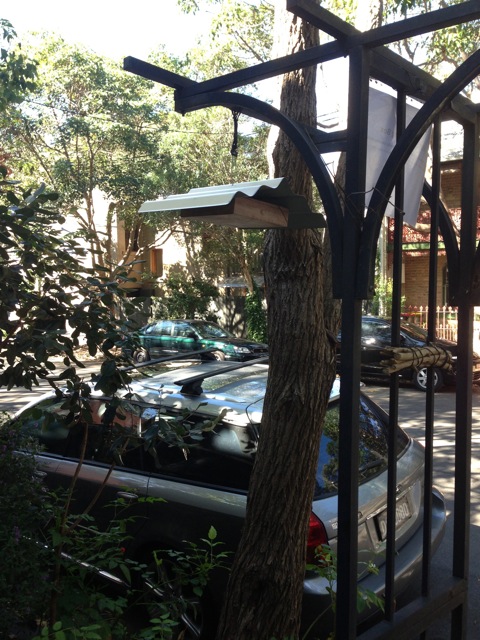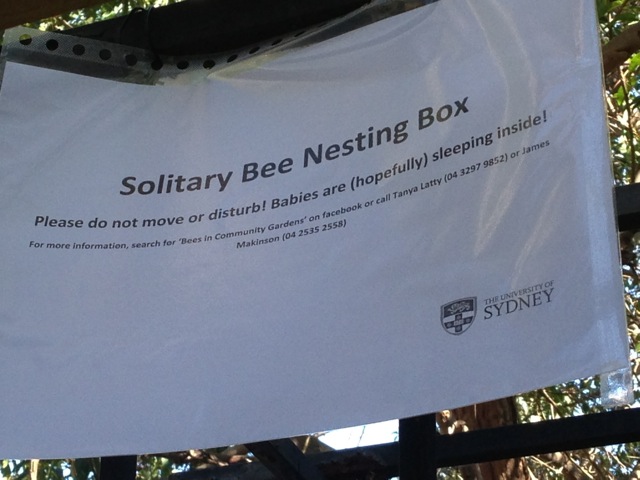Solitary bee nesting hives appear in Chippendale street
Last night two solitary bee hives appeared outside my house on the little pergola built to train up the native raspberry bushes there. One has a cute metal roof and the other is also cute – a bundle of sticks.
The sign beside it intrigues me, “Solitary bee nesting box”.
And, “Please do not move or disturb. Babies are (hopefully) sleeping inside.”
More information is on the facebook page, Bees in community gardens, and describes the research into bee nutrition in the inner city, and other locations of similar hives: The lead researcher, Tanya Latty, from Sydney University is seeking to find out what inner city bees eat and how it affects their health.
She and her colleagues use the nesting boxes to catch young bees and research what they’re eating. The little bees are not harmed during the research and are returned to where they were found.
The hives are a sign of some of the often unseen life around us, don’t you think?
I’d love to see a solitary bee take home there.
I’ll keep track of the hive and let you know the research results.
Go the little bees,
M
–
After this post Frances Winters commented on my facebook page and asked:
“Yes does solitary mean one bee or one hive? And what does nesting mean? Don’t bees nest in all their hives?”
And Tanya Latty replied on my facebook page:
‘Hi Frances, of the 1600+ bee species in Australia, only a handful (the stingless bees) live in big groups ‘hives’. The rest are solitary; individual females build their own nests, and there are no workers or queens. The single female does all the work of caring for her eggs by herself. Although the bees are solitary, many species don’t mind nesting close to other females. Our solitary bee habitats are like apartment buildings for bees. Each hole is an ‘apartment’ housing a single family of bees.”
Update: On Monday 14 October I received this email from Tanya:
Hello Everyone,
Just a quick update to let you know how the native bee project is progressing. Much to my excitement (and surprise) bees have already moved in to several of our next boxes. It is very encouraging! I’ve attached a picture showing a nest box with several sealed nest holes. Mama bee spends a week or two filling the nest with food. She lays an egg, surrounds it with food and then seals it in with wax, mud, chewed wood or a glassy cellophane like substance (depending on species). When she has filled the tunnel with eggs/food, she seals the entrance and flies away, never to return. A few weeks/months later, new adult bees will chew their way out of the nest.
The Bee team (James, Sheridan, Elisha and I) will be going around once a month (starting today) collecting nest boxes that contain completed (sealed) nests. We will replace them with fresh nest boxes so that more bees can move in. The completed nests will be kept in the lab so that we can catch and identify bees when they emerge. We will take photos of each bee (to help with identification), and weigh/measure them. We will also keep track of any parasites that emerge with them. Adult bees will be returned to their garden of origin. This method will allow us to collect data about bee abundance, diversity and health.
If you have any questions/concerns, please don’t hesitate to call or email me.
Thanks for your support!
Cheers,
Tanya
Dr Tanya Latty
ARC Postdoctoral Fellow
Behaviour and Genetics of Social Insects Lab
School of Biological Sciences
University of Sydney
+61 02 9036 5216
www.tanyalatty.com…




